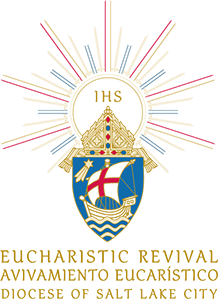Reflection 3: The Introductory Rites, Part 1
(Editor’s note: This is one in a series of reflections on the importance of the Eucharist and what it means to be a Eucharistic people. These reflections are part of the Diocese of Salt Lake City’s participation in the National Eucharistic Revival, which began June 19 and will end in July of 2024 with the National Eucharistic Congress in Indianapolis. These reflections are designed to be read aloud at Mass by a priest, deacon or experienced minister following the Prayer after Communion. They will appear in print in this newspaper and on the diocese website, www.dioslc.org. The series of reflections will continue through June of 2023 in preparation for the July 9, 2023 Diocesan Eucharistic Rally at the Mountain America Expo Center in Sandy.)
In the person of Jesus Christ, God lowered himself by becoming human and by giving himself to us in the Eucharist. In our last reflection, we spoke about how we prepare ourselves for the sacrifice of the Mass. Once we enter the church, our preparation becomes much more visible – one of the first actions we take is genuflecting towards the tabernacle, where the body of Christ is kept. Genuflecting is the act of bending the knee – by performing this action, we lower ourselves as a sign of humility before God, who is truly present. But it also reminds us of our core belief in the Eucharist: that God lowered himself for us. Finally, after preparing our bodies and our spirits, the Mass begins. The first part, the introductory rites, are a collection of actions and prayers that are small steps for us towards acknowledging the true and physical presence of Christ among us at Mass.
The first noticeable act of Mass is the entrance procession, when the priest, deacon and servers process towards the altar. Before we undergo the entrance procession, we must understand that the Mass builds up to the sacrifice of Christ in the Eucharist. Before Christ went to his death, he processed into the city of Jerusalem along with his Apostles, willingly and joyfully approaching his coming sacrifice out of love for us.
The entrance procession of Mass reminds us of this event, while at the same time indicating that the priest, who will be acting in the person of Christ in order to present the sacrifice of the Mass, is one of us – a member of our community and a humble servant of the Lord. When the priest and the deacon arrive at the altar, they will venerate it with a kiss. The altar is where Christ’s sacrifice is re-presented (not “represented”) to us, just as the altar was used for the sacrifices to God in the temple of ancient Judaism. By kissing the altar, the priest is emulating Christ, who embraced the cross upon which salvation was given to the world.
Like all prayers, the Mass will begin and end with the sign of the cross. It is one of the most distinct Catholic gestures that we all know by heart. It is also one of the oldest traditions of the Catholic faith. The gesture unites the two most fundamental beliefs of our faith which we must always keep in mind in our prayer life – the Holy Trinity (Father, Son and Holy Spirit) and the Crucifixion (in the shape of the cross which we sign ourselves with).
Once we have all performed the sign of the cross, the priest will issue a greeting to the community gathered together. It is an address to the congregation that uses the words and the formulas often used by St. Paul in his epistles. When St. Paul was writing to the individual Church communities, he emphasized that despite any distance or time, all believers and all those gathered in the name of Christ are united spiritually in their faith, but also physically in the Eucharist.
The beginning of Mass is our opportunity to remind ourselves that we are brothers and sisters in Christ, individually different parts which all make up the same mystical body of Christ. Once we receive the Eucharist, we become brothers and sisters in Christ in a more literal sense because we will have the same blood of Christ within us.
© Copyright 2025 The Diocese of Salt Lake City. All rights reserved.


Stay Connected With Us